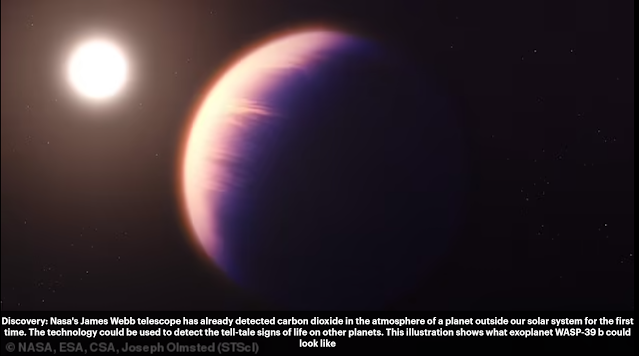Humanity will detect alien life on distant worlds in the next few years, a top British astronomer has predicted.
Professor Sasha Hinkley, associate professor of astrophysics at the University of Exeter, said it is becoming 'increasingly likely' the tell-tale signs of extraterrestrial life will be uncovered 'within his lifetime'.
He said devices such as the powerful $10billion (£7.4billion) James Webb space telescope are on the cusp of spotting 'biosignatures' - atmospheres on exoplanets with gases emitted by living things, such as oxygen that could indicate life.
It comes as a task force of experts from the UK, US and Switzerland insisted alien life would be found on thousands of worlds in the next 10 to 20 years, in what would be the greatest discovery in human history.
Prof Hinkley said: 'The likelihood of life existing in some form in the universe is quite high. Indeed, I would go as far as to say that it is looking increasingly likely that the detection of life on an exoplanet will happen in my lifetime.'
But the astrophysicist said even if tell-tale signs of life on distant worlds were detected, it may not necessarily mean an encounter with extraterrestrials.
'To be clear, the detection of life on another planet will not necessarily mean an alien civilization exists on another planet, nor that we are about to have some form of communication with such lifeforms,' he added in his article for The Spectator.
'The evidence of the discovery of life will probably be found by observing imbalances in ratios of chemical species (ozone and carbon dioxide, for example), which would not otherwise naturally exist without possibly some form of biological activity driving this disequilibrium.'
One hundred million worlds in our galaxy are able to host alien life, according to a 'conservative' prediction by NASA.
And the space agency claims that we will be able to find that life within the next 20 years, with a high chance that it will be outside our solar system.
Devices such as the James Webb space telescope, launched in 2021, are already observing the cosmos in unprecedented detail.
Its mission is to further humanity's understanding about how planets, stars and galaxies are formed and evolve.
Other hi-tech pieces of space kit are already in the pipeline, Prof Hinkley said, with Nasa now charged with the task of developing a space mission to search for biosignatures on exoplanets by the 2040s.
Space telescopes can already analyze starlight passing through a planet's atmosphere to work out its chemical makeup.
In August, astronomers announced that carbon dioxide had been discovered by the James Webb telescope in the atmosphere of a Saturn-sized planet 700 light years away.
It was the first time scientists were able to say, with certainty, they had detected gas in a planet beyond the solar system.
Particular attention is being paid to planets in the 'Goldilocks zones' where scientists believe life has the best chance of evolving and flourishing.
Planetary orbits in this zone are not too close or too far from a star, creating ideal conditions for liquid water, which is believed to be a key ingredient for life, to exist.
Its believed there could be trillions of habitable planets in the universe and hundreds of millions in our galaxy alone.
Prof Hinkley said one of the best potential areas for life in the Milky Way was in the planetary system TRAPPIST-1.
The system is about 40 light years away and is populated by seven 'roughly Earth-sized planets' closely orbiting a 'very dim and cool star not much larger than Jupiter', Prof Hinkley said.
He added: 'Three of the planets in TRAPPIST-1 orbit in the habitable zone of their host star. Efforts are already under way to target these three planets with the James Webb telescope to search for what scientists call "biosignatures".'
To date, scientists have spotted 5,332 confirmed exoplanets orbiting in some 3,931 planetary systems.
'But this isn't even the tip of the iceberg. For perspective: there are around 100 billion stars in our Milky Way,' the astronomer added.
'Since we now know from various space missions that most stars host planets, this begins to give you an indication of just how many exoplanets could exist in our galaxy.
'And then, beyond our galaxy, there are estimated to be 200 billion galaxies in the universe, each containing potentially hundreds of billions of stars with their own exoplanets.'
Last month, Dr Emily Mitchell, from the University of Cambridge, believes it is 'very likely' signs of extraterrestrial neighbours will be found, because life is almost certainly 'quite common' in the universe.
She said: 'We've only got one biosignature, here on Earth. But in 10 or 20 years my optimistic colleagues suggest we will have thousands of biosignatures. We can then work out how we compare to life on other planets.'



















No comments